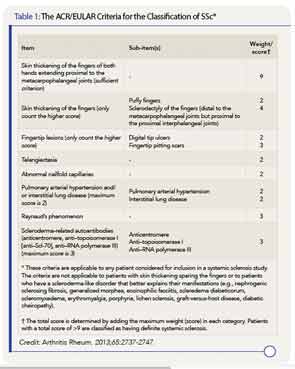The 1980 criteria “did not classify as many patients with early disease. There have also been advances in scleroderma: specific antibodies and nailfold capillary abnormalities that were not in the original criteria,” Dr. Pope says.
Developed by data collection and consensus among SSc experts from many countries in Europe and North America, the new classification system is based on clinical data and expert clinical judgment. The classification was tested repeatedly, including use of SSc cases and non-SSc controls, with the classification criteria then tested in a validation cohort and against preexisting criteria. The aims were to address a broader spectrum of SSc, including patients in the early stage of the disease; to include vascular, immunologic, and fibrotic manifestations of the disease; and to create criteria that can be used in research and clinical practice and would also be similar to diagnostic criteria if tested on early patients in the future, Dr. Pope says.
“Classification criteria are not diagnostic criteria, although they should be close,” Dr. Pope says. “The criteria help to classify more patients with SSc, where an expert would say the person has SSc, so that patients can potentially be classified earlier and then screened for important organ involvement.
“The real advance, however, is including more patients with SSc in clinical research who now meet the new criteria but did not previously meet the old criteria,” she says.

* These criteria are applicable to any patient considered for inclusion in a systemic sclerosis study. The criteria are not applicable to patients with skin thickening sparing the fingers or to patients who have a scleroderma-like disorder that better explains their manifestations (e.g., nephrogenic sclerosing fibrosis, generalized morphea, eosinophilic fasciitis, scleredema diabeticorum, scleromyxedema, erythromyalgia, porphyria, lichen sclerosis, graft-versus-host disease, diabetic cheiropathy).
† The total score is determined by adding the maximum weight (score) in each category. Patients with a total score of >9 are classified as having definite systemic sclerosis.
Credit: Arthritis Rheum. 2013;65:2737-2747.
Key Points in the New Criteria
The new classification criteria are considered superior to the 1980 criteria, with greater sensitivity and specificity. Most importantly, the classification system includes the three “hallmarks” of SSc—fibrosis of the skin and/or internal organs, production of certain autoantibodies, and vasculopathy.
Skin thickening of the fingers of both hands extending proximal to the metacarpophalangeal joints is the one criterion that, if present, can be used alone to classify a patient as having SSc. If that feature is not present, the point system created in the new criteria should be used. A score of nine or above, out of a possible 19 points, indicates a confirmed classification of SSc. Patients with skin thickening sparing the fingers are not, however, classified as having SSc.
